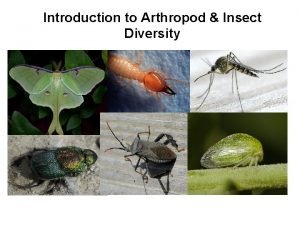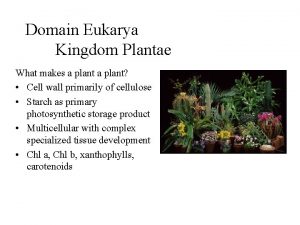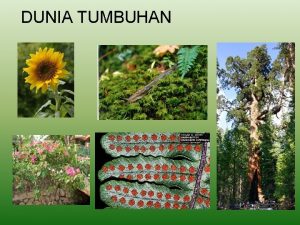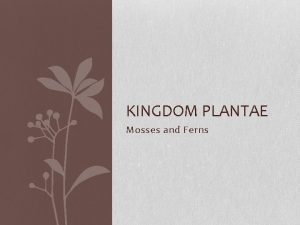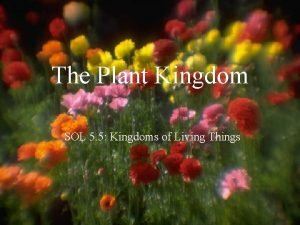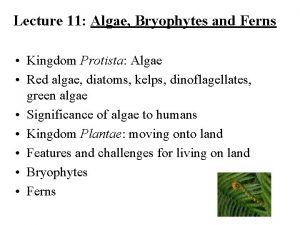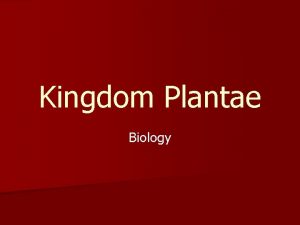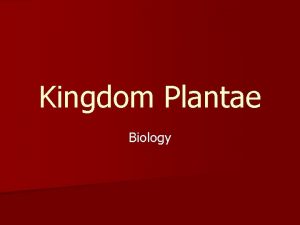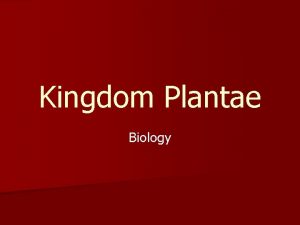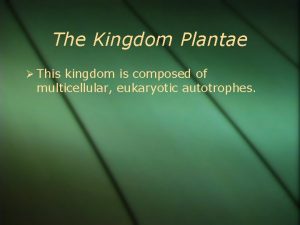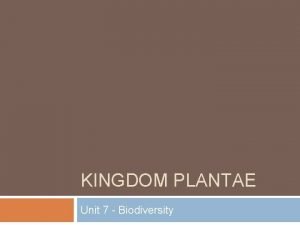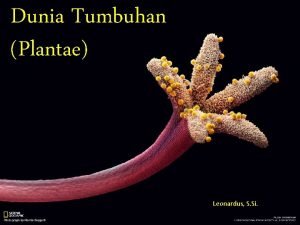Kingdom Plantae The Kingdom Plantae is composed of























- Slides: 23

Kingdom: Plantae

The Kingdom Plantae is composed of plants that are autotrophic, multicellular eukaryotes. Plant cells have cell walls made of cellulose. There approximately 300, 000 plant species that conduct photosynthesis. They include mosses (Bryophytes), ferns (Pteridophyta) and phanerogams (Gymnosperms and Angiosperms). Their leaves absorb sunlight and convert it to glucose and have a waxy coat on them to prevent water loss. Plants reproduce asexually and sexually

Group: Bryophytes, also known as mosses, is an informal group consisting of three divisions of non-vascular land plants and it includes approximately 20. 000 species. Members of the group have no vascular tissue or wood to lend them structural support, nor do they have large leaves or showy cones or flowers. Bryophytes produce enclosed reproductive structures (gametangia and sporangia) and they reproduce by spores. The group contains 3 divisions; Marchantiophyta, Anthocerotophyta, and Bryophyta.

Division: Marchantiophyta

Marchantiophyta, commonly known as hepatics or liverworts, includes about 9000 species. Its members can be found in almost all terrestrial and freshwater environments. They have a gametophyte-dominant life cycle, have a photosynthetic gametophyte, usually with indeterminate growth that develops from a protonema and produce gametophores that rise from the protonemata and bear the gametangia, antheridia, and archegonia. The sporophyte is short-lived and determinate in its growth. have a photosynthetic gametophyte, usually with indeterminate growth that develops from a protonema. The division members produce gametophores that rise from the protonemata and bear the gametangia, antheridia, and archegonia. The sporophyte is short-lived and determinate in its growth.

Division: Anthocerotophyta

Division Anthocerotophyta, also known Hornworts, includes about 150 species. The division is characterized by elongated horn-shaped sporophyte. As in mosses and liverworts, the flattened, green plant body of a hornwort is the gametophyte plant. The division contains two classes. Anthocerotopsida is the largest and best known of these, with two orders and three families.

Division: Bryophyta

The division includes approximately 10, 000 species, 700 genera, and about 110 -120 families. Its members can be found all around the world and inhabit diverse habitats. The conspicuous green leafy shoots are the gametophytes, haploid organisms, on which the diploid embryo develops into a mature sporophyte. The sporophyte is chlorophyllose and photosynthetic only in early stages of development, and it is mostly dependent on the gametophyte.

Group: Pteridophytes (Ferns)

Pteridophytes, also known as ferns, include about 12 000 species of vascular plants that do not produce seeds or flowers, reproducing instead via the production of spores. Sexual reproduction is accomplished by the release of spores, which develop in special structures called sporangia. The sporangia usually occur in clusters called sori, found on the underside of leaves. Fern leaves, often called fronds, usually arise from underground stems. The primary divisions of compound leaves are referred to as pinnae (singular: pinna), and further divisions of pinnae are known as pinnules.

Ferns are one of the oldest groups of plants on Earth, with a fossil record dating back to the 383 -393 million years ago. Recent divergence time estimates suggest they may be even older, possibly having first evolved as far back as 430 million years ago. But many of the current families and species did not appear until about 145 million years ago in the early Cretaceous, after flowering plants came to dominate many environments.

Importance Of Bryophytes play a vital role in being among the first colonizers of disturbed sites and they stabilize the soil surface, thereby reducing erosion, while at the same time reducing the evaporation of water, making more available for succeeding plants. Most Bryophytes are not of any direct economic importance, and none are a food source for humans. Sphagnum members are economically the most important mosses. The harvesting, processing, and sale of Sphagnum is a multimillion-dollar industry. Sphagnum is used in horticulture, as an energy source and, to a limited extent, in the extraction of organic products, in whiskey production, and as insulation

Division: Psilophyta

Members of the division are the only living vascular plants to lack both roots and leaves. Although they have been considered “primitive, ” recent developmental and molecular evidence suggests that the group may actually be reduced from fern-like ancestors. The psilophyte stem lacks roots; it is anchored instead by a horizontally creeping stem called a rhizome

The erect portion of the stem bears paired enations, outgrowths which look like miniature leaves, but unlike true leaves, the enations have no vascular tissue. These paired outgrowths lie immediately below the spore-producing synangia, which produce the spores. The synangia appear to be the product of three sporangia which became fused over the course of evolution and are borne on the tip of a short lateral branch. This is another feature in which the psilophytes differ from other living vascular plants; all other such plants produce their sporangia on their leaves. When the synangia mature, they open to release yellow to whitish spores, from which the gametophyte plants will later emerge. The gametophytes are very small, usually less than two millimeters long. They are subterranean and saprophytic, getting their nutrition by absorbing substances dissolved in the environment.

Division: Lycopodiophyta

Lycopodiophyta, also known as Lycopods, includes 1 subclass, 3 orders, each with one family, 5 genera, about 1, 300 species. The division is one of the oldest lineages of living vascular plants and contains extinct plants. Its earliest fossils are from 428– 410 million years ago. Its members reproduce by shedding spores and have macroscopic alternation of generations, although some are homosporous while others are heterosporous. The division contains some of the most primitive living species that reproduce by shedding spores and have macroscopic alternation of generations. Members of the division have a protostele, and the sporophyte generation is dominant

Division: Sphenophyta

The Sphenophyta is a spore-bearing division of vascular plants with both living and fossil members. Although division members were abundant and diverse in the late Paleozoic Era, Equisetum members are the only surviving represents of the division.

Division: Pterophyta

Pterophyta is the largest division of living ferns, including about 11000 species worldwide. Sporangia of the division members arise from a single epidermal cell and not from a group of cells as in eusporangiate ferns. The sporangia are typically covered with a scale called the indusium, which can cover the whole sorus, forming a ring or cup around the sorus, or can also be strongly reduced to completely absent. Many leptosporangiate ferns have an annulus around the sporangium, which ejects the spores.

REFERENCES Glime, J. M. 2017. Anthocerotophyta. Chapt. 2 -8. In: Glime, J. M. Bryophyte Ecology. Volume 1. Physiological Ecology. Ebook Husby Ch. E. , Walkowiak R. J. . 2012. An Introduction to the Genus Equisetum ( Horsetail ) and the Class Equisetopsida (Sphenopsida) as a whole. IEA Paper Yatskievych G. 2003. Pteridophytes (Ferns). Encyclopedia of Life Science. DOI: 10. 1038/ npg. els. 0003679. Url 1. : https: //meyeremma. weebly. com/kingdom-plantae. html Url 2. : http: //www. ucmp. berkeley. edu/plants/bryophyta. html Url 3. : http: //tolweb. org/Bryophyta Url 4. : https: //blogs. ubc. ca/biology 321/? page_id=39 Url 5. : https: //www. anbg. gov. au/bryophyte/classification-identification. html Url 6. : https: //www. anbg. gov. au/bryophyte/classification-mosses. html Url 7. : https: //www. fleppc. org/ID_book/ferns. pdf Url 8. : https: //www. amerfernsoc. org/about-ferns Url 9. : http: //faculty. collegeprep. org/~bernie/sciproject/Kingdoms/Plantae 3/division%20 psilophyta. htm Url 10. : http: //palaeos. com/plants/lycopodiophyta/lycopodiales. html
 Are protists eukaryotic
Are protists eukaryotic What do kingdom fungi and kingdom plantae share
What do kingdom fungi and kingdom plantae share Eukarya fungi
Eukarya fungi Old kingdom middle kingdom new kingdom
Old kingdom middle kingdom new kingdom Youtube
Youtube Old kingdom middle kingdom new kingdom
Old kingdom middle kingdom new kingdom Old kingdom middle kingdom new kingdom
Old kingdom middle kingdom new kingdom Kingdom plantae chart
Kingdom plantae chart Kingdoms characteristics chart
Kingdoms characteristics chart Biological taxonomy
Biological taxonomy Guard cells
Guard cells Subkingdom tracheobionta
Subkingdom tracheobionta Plants
Plants Types of plantae
Types of plantae Siklus lumut
Siklus lumut Characteristics of kingdom plantae
Characteristics of kingdom plantae Food vacuole eukaryotic or prokaryotic
Food vacuole eukaryotic or prokaryotic Kingdom plantae vascular and nonvascular
Kingdom plantae vascular and nonvascular Pyrrophyta
Pyrrophyta Monera, protista, fungi, plantae animalia
Monera, protista, fungi, plantae animalia Kingdom plantae diagram
Kingdom plantae diagram Ferns and algae kingdom
Ferns and algae kingdom Plantae characteristics
Plantae characteristics Plantae phylum
Plantae phylum







